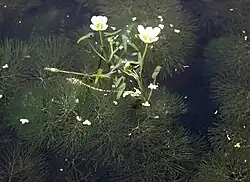Cabomba caroliniana var. caroliniana
| Cabomba caroliniana var. caroliniana | |
|---|---|

| |
| Scientific classification | |
| Kingdom: | Plantae |
| Clade: | Tracheophytes |
| Clade: | Angiosperms |
| Order: | Nymphaeales |
| Family: | Cabombaceae |
| Genus: | Cabomba |
| Species: | A.Gray
|
| Variety: | C. c. var. caroliniana
|
| Trinomial name | |
| Cabomba caroliniana var. caroliniana | |
| Synonyms[1] | |
| |
Cabomba caroliniana var. caroliniana is a variety of the species Cabomba caroliniana[2][3] in the family Cabombaceae native to the regions spanning from central and eastern USA to northeast Mexico, and Brazil to Central Argentina.[1]
Description
Vegetative characteristics
Cabomba caroliniana var. caroliniana is an aquatic,[4] perennial herb[4][5] with green to reddish brown,[6] branched, up to 10 m long,[4] and 1–2 mm wide stems.[7] The petiolate,[8] fan-shaped,[4] dichotomously or trichotomously divided submerged leaves with slim, linear lamina segments[8] are 6–7 cm wide.[7] The relatively few, narrowly elliptic,[8] peltate, green floating leaves are 5–20 mm long, and 1–3 mm wide.[6] Floating leaves may be absent entirely.[4][7]
Generative characteristics
The solitary,[4] pedicellate,[7] white, 6–15 mm wide flowers[6] float on the water surface, or extend 2–4 cm above it.[4] The flowers have three[6] white or cream,[8] obovate to elliptic, 5–12 mm long, and 2–7 mm wide sepals.[6] The three[6] white or cream,[8] elliptic-obovate petals are 4–12 mm long, and 2–5 mm wide.[6] The androecium consists of 6 stamens with 4 mm long filaments.[7] The gynoecium consists of 2–4 carpels.[8] The fruit with a recurved pedicel[7] bears ellipsoid-oblong to ovate, 1.5–3 mm long, and 1–1.5 mm wide seeds.[6]
Cytology
The chromosome count is 2n = ca. 78, ca. 104.[6]
Taxonomy
It is an autonym.[9][10] Some sources regard the variety Cabomba caroliniana var. pulcherrima as synonymous to Cabomba caroliniana var. caroliniana.[11][12]
Etymology
The varietal name caroliniana means from the Carolinas.[13]
Distribution and habitat
It is native to Argentina, Bolivia, Brazil, Mexico, Paraguay, Uruguay, and the USA.[1] It has been introduced to Australia,[8][7] Austria, China, Germany, India, Japan, Korea, Malaysia, the Netherlands, New Caledonia, New Zealand, Poland, Romania,[1] Serbia,[14] Sri Lanka, Sweden, Thailand, and the UK.[1]
Ecology
The flowers are insect-pollinated.[15]
Cultivation
It is cultivated as an ornamental plant in aquaria[8][16] and in ponds.[8]
References
- ^ a b c d e Cabomba caroliniana var. caroliniana. (n.d.). Plants of the World Online. Retrieved June 25, 2025, from https://powo.science.kew.org/taxon/urn:lsid:ipni.org:names:77167762-1
- ^ Cabomba caroliniana var. caroliniana. (n.d.-c). WFO Plant List. Retrieved June 26, 2025, from https://wfoplantlist.org/taxon/wfo-0000705188-2025-06?page=1
- ^ Cabomba caroliniana var. caroliniana. (n.d.-b). GBIF | Global Biodiversity Information Facility. Retrieved June 25, 2025, from https://www.gbif.org/species/7096647
- ^ a b c d e f g Wood, B. (n.d.). Cabomba caroliniana. Plants of South Eastern New South Wales. Retrieved July 23, 2025, from https://apps.lucidcentral.org/plants_se_nsw/text/entities/cabomba_caroliniana.htm
- ^ Cabomba caroliniana A. Gray var. caroliniana. (n.d.). USDA Plants Database. Retrieved June 25, 2025, from https://plants.sc.egov.usda.gov/plant-profile/CACAC4
- ^ a b c d e f g h i Cabomba caroliniana var. caroliniana. (n.d.-d). e-Flora of Thailand. Retrieved June 26, 2025, from https://botany.dnp.go.th/eflora/florainfra.html?tdcode=07015
- ^ a b c d e f g Royal Botanic Gardens Victoria. (n.d.). Cabomba caroliniana var. caroliniana. VicFlora Flora of Victoria. Retrieved June 25, 2025, from https://vicflora.rbg.vic.gov.au/flora/taxon/e29e2172-31c0-438e-9151-61174823a5a7
- ^ a b c d e f g h i T.D. Stanley, A.E. Orchard, P.G. Kodela. Cabomba caroliniana var. caroliniana, in P.G. Kodela (ed.), Flora of Australia. Australian Biological Resources Study, Department of Climate Change, Energy, the Environment and Water: Canberra. https://profiles.ala.org.au/opus/foa/profile/Cabomba%20caroliniana%20var.%20caroliniana [Date Accessed: 26 June 2025]
- ^ Missouri Botanical Garden. (n.d.). Cabomba caroliniana A. Gray var. caroliniana. Tropicos. Retrieved June 25, 2025, from https://www.tropicos.org/name/22600266
- ^ Cabomba caroliniana A.Gray var. caroliniana. (n.d.). Australian National Species List (auNSL). Retrieved June 25, 2025, from https://id.biodiversity.org.au/name/apni/202719
- ^ USDA, Agricultural Research Service, National Plant Germplasm System. 2025. Germplasm Resources Information Network (GRIN Taxonomy). National Germplasm Resources Laboratory, Beltsville, Maryland. URL: https://npgsweb.ars-grin.gov/gringlobal/taxon/taxonomydetail?id=416937. Accessed 25 June 2025.
- ^ U.S. Fish & Wildlife Service. (2015, March). Carolina Fanwort (Cabomba caroliniana) Ecological Risk Screening Summary.
- ^ Sonday, B., Bradtke, J., Burnham, R. J., & University of Michigan. (n.d.). Vicia caroliniana Walter. CLIMBERS Censusing Lianas in Mesic Biomes of Eastern Regions. Retrieved July 23, 2025, from https://climbers.lsa.umich.edu/vicia-caroliniana/
- ^ Vukov, D., Jurca, T., Rućando, M., Igić, R., & Miljanović, B. (2013). Cabomba caroliniana A. Gray 1837: A new, alien and potentially invasive species in Serbia. Archives of Biological Sciences, 65(4), 1515-1520.
- ^ Jacobs, M. (2008). Predicting spread of the invasive macrophyte Cabomba caroliniana in Ontario.
- ^ Cabomba caroliniana var. caroliniana - Karolina-Haarnixe. (n.d.). Flowgrow. Retrieved June 26, 2025, from https://www.flowgrow.de/db/wasserpflanzen/cabomba-caroliniana-var-caroliniana